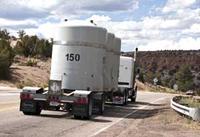-
Large-scale production of algae-based biofuels poses sustainability concerns

Scaling up the production of biofuels made from algae to meet at least 5 percent — approximately thirty-nine billion liters — of U.S. transportation fuel needs would place unsustainable demands on energy, water, and nutrients, says a new report from the National Research Council; these concerns, however, are not a definitive barrier for future production, and innovations that would require research and development could help realize algal biofuels’ full potential
-
-
Looming sequestration causes Navy to looking at future technology, fleet size

Adm. Mark Ferguson, vice chief of naval operations, offered a revealing look at the potential future for the Navy if sequestration, or automatic defense cuts, goes into effect in January; without some sort of adjustment by Congress, currently the subject of discussion on Capitol Hill, the nearly 10 percent across-the-board Department of Defense budget cuts are slated to commence in 2013 and continue for ten years
-
-
Assessing bridge resilience
Across the United States, more than 600,000 bridges link travelers to millions of roadway miles, forming a critical part of the nation’s infrastructure; because bridges are typically more vulnerable than roadways to damage caused by natural and man-made hazards, they are also of interest to DHS, which funds cutting-edge research in various aspects of structural integrity testing and blast-resistant structural design
-
-
Ideas from nature on how to convert solar into liquid fuel
It has long been a dream of scientists to use solar energy to produce chemicals which could be stored and later used to create electricity or fuels; a recent scientific breakthrough is providing hope that this may soon be possible; the development would offer many benefits, including the ability to store chemicals until needed — current solar power technology has difficulties in this area
-
-
Faster data analysis on tactical handheld devices
The Office of Naval Research (ONR) announced a new program to optimize tactical handheld technology for quick decision-making in the field; the Exchange of Actionable Information at the Tactical Edge (EAITE) program, designed to sift through data from multiple sources for faster analysis
-
-
Analyzing the sound of rain falling on a bridge reveals bridge’s health, stability

Engineers have found that by listening to how a highway bridge sings in the rain, they can determine serious flaws in the structure; employing a method called impact-echo testing, engineers can diagnose the health of a bridge’s deck based on the acoustic footprint produced by a little bit of water
-
-
Thriving in toxic environments
Not long ago, a group claimed that these microorganisms, which live in an environment that is rich in the arsenic-based compound arsenate, could take up that arsenate and use it — instead of the phosphate on which all known life on Earth depends; the claim, since disproved, raised another question: How do organisms living with arsenate pick and choose the right substance? Scientists reveal how bacteria living in toxic environments identify and expel the poison
-
-
Twenty-year anniversary of U.S. last full-scale nuclear test
The first U.S. nuclear test, code named Trinity, took place in southern New Mexico forty-seven years earlier, on 16 July 1945; in all, the United States conducted 1,030 nuclear tests – the last one, code-named Divider, took place twenty years ago, on 23 September 1992
-
-
Los Alamos lab accelerates shipment of nuclear waste to permanent storage site

Los Alamos National Laboratory broke its own records in the first year of accelerated shipping effort of nuclear waste from the Lab to permanent disposal facilities located twenty-six miles outside of Carlsbad, New Mexico
-
-
Cosmic rays help gather information from inside the Fukushima nuclear reactors
Researchers have devised a method to use cosmic rays to gather detailed information from inside the damaged cores of the Fukushima Daiichi nuclear reactors which were heavily damaged in March 2011 by a tsunami that followed a great earthquake
-
-
A Mississippi river diversion helped build Louisiana wetlands
The extensive system of levees along the Mississippi River has done much to prevent devastating floods in riverside communities; the levees, however, have also contributed to the loss of Louisiana’s wetlands; by holding in floodwaters, they prevent sediment from flowing into the watershed and rebuilding marshes, which are compacting under their own weight and losing ground to sea-level rise
-
-
Corps: absolute flood protection along the Missouri River is impossible
A U.S. Army Corps of Engineers report said that absolute flood protection along the Missouri River is impossible, so the basin needs to prepare and plan for flooding in the future
-
-
Ozone causes forests to use more water, reducing availability in the Southeast

Scientists have found that rising levels of ozone, a greenhouse gas, may amplify the impacts of higher temperatures and reduce streamflow from forests to rivers, streams, and other water bodies; such effects could potentially reduce water supplies available to support forest ecosystems and people in the southeastern United States
-
-
New app uses scattered public information to put together a digital footprint of individuals, organizations

A new app application can collect scattered online clues to provide a picture of individuals or organizations; the application draws on public data sources in order to put together a graphical digital footprint
-
-
New military apparel repels chemical, biological agents
Scientists are developing a new military uniform material that repels chemical and biological agents using a novel carbon nanotube fabric; the material will be designed to undergo a rapid transition from a breathable state to a protective state; the highly breathable membranes would have pores made of a few-nanometer-wide vertically aligned carbon nanotubes that are surface modified with a chemical warfare agent-responsive functional layer
-
More headlines
The long view
Are We Ready for a ‘DeepSeek for Bioweapons’?
Anthropic’s Claude 4 is a warning sign: AI that can help build bioweapons is coming, and could be widely available soon. Steven Adler writes that we need to be prepared for the consequences: “like a freely downloadable ‘DeepSeek for bioweapons,’ available across the internet, loadable to the computer of any amateur scientist who wishes to cause mass harm. With Anthropic’s Claude Opus 4 having finally triggered this level of safety risk, the clock is now ticking.”
A Brief History of Federal Funding for Basic Science
Biomedical science in the United States is at a crossroads. For 75 years, the federal government has partnered with academic institutions, fueling discoveries that have transformed medicine and saved lives. Recent moves by the Trump administration — including funding cuts and proposed changes to how research support is allocated — now threaten this legacy.
Bookshelf: Preserving the U.S. Technological Republic
The United States since its founding has always been a technological republic, one whose place in the world has been made possible and advanced by its capacity for innovation. But our present advantage cannot be taken for granted.
Autonomous Weapon Systems: No Human-in-the-Loop Required, and Other Myths Dispelled
“The United States has a strong policy on autonomy in weapon systems that simultaneously enables their development and deployment and ensures they could be used in an effective manner, meaning the systems work as intended, with the same minimal risk of accidents or errors that all weapon systems have,” Michael Horowitz writes.
Ukraine Drone Strikes on Russian Airbase Reveal Any Country Is Vulnerable to the Same Kind of Attack
Air defense systems are built on the assumption that threats come from above and from beyond national borders. But Ukraine’s coordinated drone strike on 1 June on five airbases deep inside Russian territory exposed what happens when states are attacked from below and from within. In low-level airspace, visibility drops, responsibility fragments, and detection tools lose their edge. Drones arrive unannounced, response times lag, coordination breaks.
Shots to the Dome—Why We Can’t Model US Missile Defense on Israel’s “Iron Dome”
Starting an arms race where the costs are stacked against you at a time when debt-to-GDP is approaching an all-time high seems reckless. All in all, the idea behind Golden Dome is still quite undercooked.
